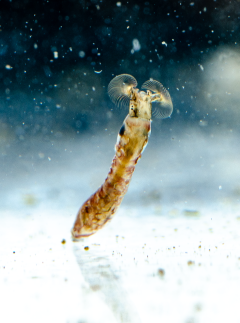An increase in blood-sucking black flies is expected in Germany
The habitat suitability for the medical relevant insects has been modelled over four federal states
Researchers from Goethe University Frankfurt and the Senckenberg Biodiversity and Climate Research Centre have modeled the spatial distributional patterns of black flies in Hesse, North Rhine-Westphalia, Rhineland-Palatinate and Saxony for the first time. In the study published in the renowned journal “Science of the Total Environment”, the research team shows that black flies in Germany can be categorised into three groups with different distribution patterns and ecological requirements. The researchers point out that medically relevant species in particular could become more prevalent as a result of ongoing climate and land-use change.
Only six milimeters in length, black flies (Simuliidae) may look harmless like house flies, but their bites can be very unpleasant. Similar to mosquitoes, the females of these insects that are able to fly need a blood meal to produce eggs. Known as ‘pool feeders‘ they use their sharp ‘teeth’ to scratch the skin of the host and then ingest the resulting drop of blood. „The anticoagulant and anaesthetic substances introduced into the wound by mosquitoes can trigger serious allergic reactions or lead to secondary bacterial infections,” states Prof. Dr. Sven Klimpel from the Senckenberg Biodiversity and Climate Research Centre, Goethe University Frankfurt, the LOEWE Centre for Translational Biodiversity Genomics (TBG), and the Fraunhofer IME Giessen. Klimpel continues: “Black flies are also vector-competent, meaning they are able to transmit pathogens that cause infectious diseases through their bites.” One of the most well-known diseases transmitted by black flies is onchocerciasis, also known as ‘river blindness’, caused by the nematode Onchocerca volvulus, which is native to Africa. According to the World Health Organisation, more than 1.15 million people worldwide have already lost their sight as a result of the disease.
Black flies can be found on all continents except Antarctica. Over 2000 black flies species are known worldwide, in Germany 57 of them. According to Sarah Cunze, from the Goethe University Frankfurt and the first author of the Study, almost all black fly species (98%) require a blood meal bevore laying their eggs. “In our study, we were able to categorise the 12 most common species into three biogeographical groups” explains Cunze, “these groups are a) montane species living upper reaches of watercourses, b) species with braod niches and thus widely distributed across different landscapes and c) lowland species.” These results are based on a valid data set comprising 1,526 records of black fly larvae in the four federal states of Hesse, North Rhine-Westphalia, Rhineland-Palatinate and Saxony and provide valuable insights of the distributional patters of these species.
In their study, the researchers deduce different trends in population development for the three groups under the ongoing climate and land use change: While the montane group is considered to be at risk due to increasing temperatures and growing chemical pollution of water bodies, the other species are characterised by a broad niche or higher tolerance to anthropogenic changes. Consequently, the blackfly species of veterinary and human medical relevance, which predominantly belong to the third group, could be promoted by the ongoing anthopogenic change and be subject to positive population trends. “Medically relevant species are characterised by particularly aggressive biting behaviour against mammals and humans and often occur in very high numbers. These observed mass occurrences are the result of synchronised hatching of the aquatic larvae”, explains Sarah Cunze. Neighboring countries like Poland have responded to this mass occurrence, by keeping livestock only indoors or letting them out to graze only at night during these outbreaks. “The expected future rise in temperature could reduce development times and thus lead to more generations per year – resulting in a more frequent occurrence of black flies overall,” adds Cunze.
In further studies, the team would like to support its findings with empirical research and use laboratory tests to clarify the extent to which the simuliid species are vector-competent, – i.e. capable of transmitting certain pathogens – under the conditions currently prevailing in Europe. “The trends for medically relevant blackfly species derived from the findings of our study are an example of how global changes can promote vector-borne infectious diseases. Our modelling approaches and results will help us to structure monitoring and prevention programs for vector-competent species more efficiently and to provide predictions about future developments,” concludes Klimpel.






